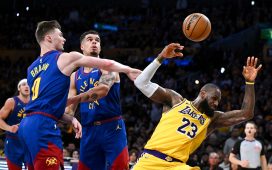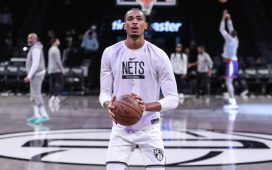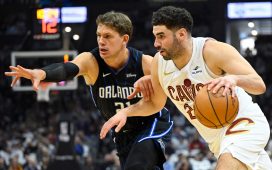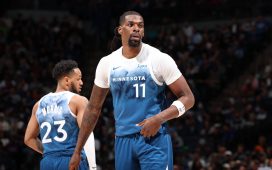The thing about the NBA MVP award is that only one person can win it, which makes things a bit problematic when multiple players appear to be having MVP-caliber seasons.
I wrote about this dilemma a year ago, when three players had bonkers campaigns that would have made them runaway winners in any normal year. Instead, Nikola Jokić narrowly won a second straight MVP award over Joel Embiid and Giannis Antetokounmpo.
Granted, we’re not even halfway through the 2022-23 season yet, but this year’s MVP traffic only seems worse. To wit:
- Boston’s Jayson Tatum has been the best player on the league’s best team, automatically bestowing MVP equity. And this isn’t on the same level as the “You have to consider Devin Booker because the Suns won 64 games” vibe of a year ago. Tatum legitimately has a case for being the best player this time around, as a two-way menace averaging 30.9 points per game for the league’s best offense. He punctuated his candidacy with a 41-points-on 22-shots tour de force against mighty Milwaukee on Christmas.
- Kevin Durant has spent the past month reminding everyone how amazing he is. Durant is averaging 29.3 points on 68 percent true shooting since the beginning of November, and his defense has been on par, if not even better than his offense. The Nets have won nine straight to pass Cleveland and Philly in the standings and are breathing down the necks of Boston and Milwaukee for the top spot. At age 34, Durant has also played in 33 of Brooklyn’s 34 games and is third in the NBA in minutes.
- Luka Dončić is an offense unto himself for a short-handed Dallas team, one that is ninth in the NBA in offensive efficiency despite having virtually no shot-creation anywhere else on the roster. On top of his ever-widening array of tricks, feints and pivots in the basket area, Dončić has massively increased his free-throw rate in his fifth pro season while shooting a scalding 58.1 percent inside the arc. He’s third in the league in PER, second in scoring and second in BPM despite the near-constant attention from defenses.
- Giannis? No, he didn’t go anywhere. The Bucks superstar is fourth in scoring, leads the league in free-throw attempts and remains a monstrous presence for the league’s fifth-ranked defense despite a dip in his PER to “just” 28.1 so far.
- Embiid is still here too. He got off to a slow start, but quickly made up for lost time, to the point that he now leads the league in scoring. A lack of durability could again work against him – he has already missed eight games – but at his current rate, it might not matter. Embiid’s December splits are truly ridiculous: 35.9 points, 50 percent from 3, 86.4 percent from the line, 65.8 percent true shooting, more assists than turnovers and eight straight wins for the Sixers. He’s also played every game since Nov. 28.
All of this would make for an amazing five-way MVP race! How we do choose?
Except for one inconvenient fact … the Joker.
The two-time reigning MVP is still here, clowning fools in slow motion with no-look passes, impossibly soft running floaters and all the other random cool stuff he does that seems impossible for a huge ground-bound guy until he does it.
Here, have a Smitty from your opponent’s giant center:
That’s from Nikola Jokić’s 41-point, 15-rebound, 15-assist triple-double against Phoenix on Christmas night, which was notable mostly for how unremarkable it seemed. He was just kind of having a regular game for him and ended up compiling these stats. At 24.4 points, 11.0 rebounds and 9.4 assists per game, Jokić has an outside shot at averaging a triple-double for the season.
The NBA hasn’t had an MVP three-peat since Larry Bird (1984-86), and those of you suffering from Joker fatigue in the MVP vote will need to do some soul searching again this season. Jokić’s PER of 32.2 not only leads the league, but also nearly matches last season’s career high. His 12.4. BPM leads the league by a wide margin … and it’s also higher than his first MVP season.
His 68.5 percent true shooting? Well, it doesn’t lead the league, but it does for medium- to high-usage players (anyone over 20 percent) and it is easily the best mark of his career. Durant is choking on his dust back at 67.3. There’s a good reason for this: Jokić has cut back sharply on taking 3s after hitting 33.7 percent a year ago, flinging them barely half as often as last year to instead move to his comfort zone from midrange. (Fun stat: Jokić is shooting 61 percent this season on midrange shots, according to Cleaning the Glass. What?!?!)
His 45.7 percent assist percentage? No, that doesn’t quite lead the league. Dončić and Indiana’s Tyrese Hailburton are still slightly ahead of him. But, did I mention Jokić is a center? His rate is nearly twice that of any other five (Embiid is next at 24.4), and yes, is a career high for a player who already was cemented as the best passing big man of all time before the season tipped off.
All of this would be easy to write off were it not for one other inconvenient fact: Jokić’s team is also in first place in the West at 21-11, a half game ahead of second-place New Orleans.
The biggest argument against the Joker the past two years – and the biggest reason voter fatigue was likely to get in the way of a three-peat – was that the Nuggets were good, but not among the league’s elite, winning 47 and 48 games, respectively. Well, what now? What if they finish first in the West, with the team still hemorrhaging points any time Jokić leaves the floor? This year’s Nuggets have a whopping TWENTY-FIVE-POINT differential between having Jokić on the court (plus-11.3 points per 100 possessions) and off it (minus-13.6 points).
No amount of staggering or tinkering has seemed able to fix this, although the Nuggets’ recent stretch of seven wins in eight games has seen more stability from the second group. If they finish first in the West with the team going instantly into tire-fire mode anytime Jokić leaves the floor, how could he not be the MVP?
There’s still more than half a season to play and torrents of water left to go under the bridge. Injuries will inevitably scratch a few names from the race. Slumps may do so as well; the Nuggets are hardly ironclad with their half-game lead atop the West, especially given that they rank only 11th in net margin of victory and 25th in defense. (Jokić, for all his positives, is not exactly an imposing rim protector; he has good hands and positions himself well, but to date, his greatest defensive accomplishment has been mastering the kick-ball violation.) And maybe Durant renders all this discussion irrelevant by averaging 35 a game during a 20-game win streak or something.
But the Nuggets’ unexpected appearance at the top of the standings, despite still trying to incorporate Jamal Murray and Michael Porter Jr. through an uneven first half of the season, makes for some interesting conversation for the second half.
The presumption heading into the season was that Joker fatigue would take over the MVP race, and voters would shift toward rewarding a player whose team was at or near the top of the standings.
But what if that player turns out to be Nikola Jokić?
Travel Geekery: What is G League Ignite’s future?
I’m back from the G League Showcase in Las Vegas, a wonderful annual event that brings together all 30 teams in the G League and allows everyone in the NBA to scout them in one place, timed just before key roster decisions are made ahead of the league’s guarantee date.
I’ve already written my missive about much of the trade and expansion discussion there, but I did leave one item out for today, which was a larger discussion about one of the teams there: G League Ignite.
Unlike 28 of the other 29 teams, the Ignite are not affiliated with any NBA team. (Mexico City is also unaffiliated. Portland and Phoenix are the only NBA teams without affiliated G League clubs.) Instead, they are run by the league and pay considerable salaries to several young players with the idea of developing them for the NBA. This season, that roster includes Scoot Henderson, London Johnson, Mojave King, Sidy Cissoko, Babacar Sané and Efe Abogidi.
The program is in its third year and has sent Dyson Daniels, Jaden Hardy, MarJon Beauchamp, Jalen Green, Daishen Nix, Isaiah Todd and Jonathan Kuminga to the NBA. However, in talking to people around the league, both leading up to the event and at the event itself, I found a lot of people willing to question the league’s approach.
For starters, why is the league spending all this money to develop players who would just … develop someplace else? What is the point of this, exactly? There was some idea that keeping these players out of rival non-NCAA options like Overtime Elite or the Australian Next Stars program would help market them for the next level, but the G League isn’t exactly playing to packed houses. Meanwhile, with NIL money now a factor in college basketball, will any of these options even be competitive going forward?
From a marketing perspective, thus far the biggest impact of G League Ignite was providing an opponent for Victor Wembanyama’s Metropolitans 92 team when it visited in October. That two-game set massively helped fan the hype machine for next year’s likely top overall pick.
Given the expense, some have questioned the league’s roster choices as well. Paying up for Henderson might be one thing, but most of the other players are fringe prospects. As one league source wondered: “Why are we paying almost half a million for a two-way guy?”
Secondly, there is a deeper question: Is this program even any good at developing players? Maybe you give them a mulligan for the first year in mid-pandemic, but Ignite were objectively a mess last season and seem only slightly better this season. Nobody I’ve talked to thinks the team is well coached or well run, and I am frequently offered this opinion before I can get around to asking about it.
Meanwhile, Hardy looks a million times better on Dallas’s G League team than he did on the Ignite a year ago. Scouts are almost at the point of putting as asterisk next to Ignite players’ numbers, presuming they’ll be better almost anywhere else. Many also question that they aren’t playing for anything that matters, especially relative to an NCAA season. “Every game is the combine for them,” said one league source who offered a similar critique of Overtime Elite.
Ignite left the Showcase with the worst record and worst scoring margin in the G League after nearly doing the same a year ago. (Last season’s games were technically counted as exhibitions except for their 14 Showcase Cup contests; the Ignite went a combined 9-21). Henderson has played only six games; the Ignite won three of those, but are 1-11 without him. They also split two games against Wembanyama’s Metropolitans 92 team in Las Vegas.
Perhaps my characterization goes too far. Canadian forward Leonard Miller has shown clear progress over the course of the season, to give one example, and could push his way into the 2023 first round. (I recently profiled Miller here.) The record, certainly, would look a lot better if Henderson were playing. And if we’re comparing, it’s not like LaMelo Ball had some insane personal growth experience in Australia – he spent the year screwing around and jacking up 40-foot 3s.
So instead, let’s just say that the program has reach a point where people are asking questions. Unlike the G League’s other 29 franchises, this one has to continue proving to 30 NBA owners why it should keep existing. Right now, the sales pitch is falling a bit flat.
Rookie of the Week: Christian Braun, SG, Denver Nuggets
(Note: This section won’t necessarily profile the best rookie of the week. Just the one I’ve been watching.)
A late first-round pick (21st) after winning a national title at Kansas, Braun has seen steady sprinkles of minutes in the first half of the year, which figures to only increase as the grind of the season inevitably pecks away at Denver’s depth. The 6-foot-7 wing played 20 or more minutes five times in the last two weeks, then got a 12-minute run in the Nuggets’ win over Phoenix on Christmas.
At first glance, you’re not going to be blown away. He scored a season-high 13 points against Memphis last Tuesday, but the offensive output is not exactly flattering. Braun has been borderline invisible, with an 11.2 percent usage rate, and has made only 11 3-point shots in 29 games. If you’re looking to expand the sample size, his preseason and summer league weren’t any better: 5-for-31 on 3s and just 21-for-36 from the line, combined. About the best thing you could say is that he’s managed to stay out of the way, with just 10 turnovers in 29 games.
Braun isn’t shifty on the ball, but he’s big for his position and a plus athlete in straight lines. He should be able to leverage this threat into a few more transition opportunities as he finds his NBA sea legs. Meanwhile, his push shot from the perimeter had many suspicious of how it might translate to the pros, especially off the dribble. But he did pull this one out of his bag on Christmas. A stepback going right? OK then …
Braun’s offensive role in the near term isn’t likely to expand much beyond “guy who stands in the corner.” But the biggest reason to remain interested in Braun’s long-term prospects is at the defensive end, where his size and mobility could translate into a stopper eventually. He got multiple shifts against Chris Paul on Christmas and generally held his own. Watch here as he traces Paul across the lane and doesn’t let him get to his preferred office space for a pull-up at the free-throw line.
However, the part I enjoyed most was this cat-and-mouse game in the clip below. Normally a 6-0 guy posting up a 6-7 guy wouldn’t draw our attention, but this is Chris Paul and his Jedi Mind Tricks on a rookie defender. Nonetheless, watch how Braun is aware of Paul trying to “rip move” himself into a cheap foul and continues moving his left arm in and out of position, with a motion almost like a rodeo cowboy. This is some advanced stuff for a rookie:
With the Nuggets pushing for the top spot in the West (see above), Braun has suddenly become a rookie who matters. That may change, of course, depending on trade deadline maneuvers. It could also hinge on his ability to provide something — anything, really — at the offensive end. But right now he’s the fourth wing for a contender, ranking ninth on the club in minutes.
Could he be a repeat champion? Dare to dream.
Prospect of the Week: Maxwell Lewis, 6-7, Soph., SF, Pepperdine
(Note: This section won’t necessarily profile the best prospect of the week. Just the one I’ve been watching.)
Could the WCC have a non-Gonzaga first-round pick for the second straight year?
We may be headed that way. Scouts were extremely late to the game with Santa Clara’s Jalen Williams a year ago, with many not even getting out to see him before the WCC tournament in March. I suspect they’ll arrive more on time with Lewis, especially after his team’s tournament in Hawaii this past week offered some of the few college games worth televising in the Christmas doldrums before conference play begins.
At 6-7 with a solid handle and a 42.9 percent mark on 3-pointers this season, Lewis has definitely established himself as a person of interest for the 2023 draft. Pedants will note that he’s a bit old for a sophomore (he turns 21 in July), and that his push-out jumper may not translate easily against NBA size. This clip offers a look:
Eight points in four minutes … gonna be one of those games for @maxwelll2002 pic.twitter.com/TFVhjK0f1w
— Pepperdine Men’s Basketball (@PeppBasketball) December 19, 2022
That said, a wing with prototype size who can shoot and jump is going to get people on planes, especially when his home gym is perhaps the best winter scouting trip in the continental U.S. (Pepperdine is set on a hill over the beach in Malibu. It’s delightful. Trust me.)
Lewis isn’t just a shooter; he offers just enough on-ball juice and athleticism to be interesting. Check out this drive, for instance. Sure, it’s against Hawaii and an elite big might have smashed this finish off the glass, but this is a pretty smooth crossover and glide into a right-hand finish.
Lewis likely will stay under the radar nationally all year given that he plays for the 143th-ranked team in KenPom. (Only one conference team ranks lower; the Waves are just 7-7, with two non-Division I wins.) But pro scouts will find him. The quality of his team, actually, is the biggest thing working against him right now. If he’s so good, why isn’t his team better?
Scouts will also want to see him against higher-level competition, and that’s where the WCC season gets really interesting. Pepperdine has only played three games against teams ranked in the KenPom top 100 and was demolished, 100-53, by UCLA, the one high-major team it played.
However, the conference slate brings two games each against Gonzaga, St. Marty’s and BYU (not to mention frisky rivals like San Francisco and Portland). The New Year’s Eve tilt at Gonzaga, on a light night for college games, may draw some extra eyeballs.
In other words, I’d characterize this one as very much an eval-in-progress. Yet there is little doubt already that Lewis has a toolset that gives him the benefit of the doubt from evaluators. That and a good conference season could easily see him vault into the first round on draft night.
(Top photo of Nikola Jokić: Bart Young / NBAE via Getty Images)









